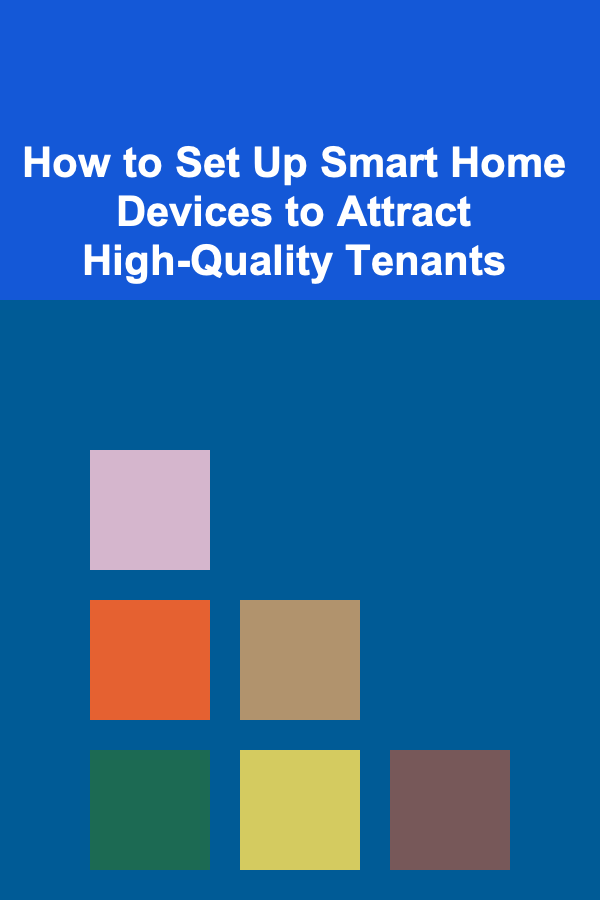
How to Set Up Smart Home Devices to Attract High-Quality Tenants
ebook include PDF & Audio bundle (Micro Guide)
$12.99$8.99
Limited Time Offer! Order within the next:

In today's competitive rental market, landlords are constantly looking for ways to stand out from the crowd and attract high-quality tenants. One of the most effective ways to do so is by integrating smart home devices into your rental property. Smart home technology not only adds convenience and comfort for tenants, but it also increases the property's appeal by making it more energy-efficient, secure, and modern. By setting up smart home devices strategically, landlords can create a property that is both functional and enticing to potential renters.
In this article, we will explore the different types of smart home devices that can enhance your rental property, how to set them up properly, and the key benefits they provide to both landlords and tenants. Whether you are a seasoned landlord or new to the rental business, this guide will help you understand how to leverage smart home technology to attract high-quality tenants.
Understanding Smart Home Devices and Their Benefits
Smart home devices are electronic devices that can be controlled remotely through a smartphone, tablet, or voice assistant. These devices use Wi-Fi or Bluetooth to connect to the internet and can be monitored and adjusted in real-time. Popular smart home devices include smart thermostats, lights, locks, security cameras, and more. The primary benefits of smart home technology are convenience, energy efficiency, and security, all of which are attractive to tenants.
1. Convenience and Comfort
Smart devices enhance the convenience of daily living by offering automation and remote control. Tenants can adjust the lighting, temperature, and security features of the property from the palm of their hands, whether they are at home or away. Smart home technology can create a personalized living experience, allowing tenants to tailor their environment to suit their preferences.
2. Energy Efficiency
With the growing focus on sustainability and reducing energy consumption, smart home devices can play a significant role in lowering utility costs. Devices like smart thermostats, smart lights, and energy-efficient appliances help tenants control their energy use, which is both eco-friendly and cost-effective. This appeals to tenants who are conscious of their carbon footprint and budget.
3. Security and Safety
Smart home devices offer enhanced security features that help keep tenants and their property safe. From video doorbells and smart locks to motion detectors and security cameras, these devices offer peace of mind. Tenants will appreciate knowing that their home is equipped with the latest security technology, making it less likely that they will experience theft or break-ins.
4. Attracting High-Quality Tenants
High-quality tenants are typically those who value convenience, security, and efficiency. These tenants tend to stay longer, pay their rent on time, and take better care of the property. By offering smart home features, you show that you are a modern, forward-thinking landlord who cares about providing a top-tier living experience.
Types of Smart Home Devices to Attract High-Quality Tenants
To attract high-quality tenants, you should consider installing smart home devices that meet their needs and preferences. Here are some of the most popular and impactful smart home devices to incorporate into your rental property.
1. Smart Thermostats
A smart thermostat is one of the most valuable and cost-effective smart home devices you can install in your rental property. These devices allow tenants to control the temperature of the home remotely, set schedules for heating and cooling, and even adjust the temperature using voice commands through smart assistants like Amazon Alexa or Google Assistant.
Benefits for Tenants:
- Energy Savings: Smart thermostats learn the tenants' preferences and adjust accordingly to optimize energy use, which can help reduce heating and cooling costs.
- Convenience: Tenants can control the temperature remotely, ensuring that the home is always at the right temperature when they arrive.
- Sustainability: Many tenants are eco-conscious, and a smart thermostat can help reduce the environmental impact by saving energy.
Popular Smart Thermostats:
- Nest Learning Thermostat
- Ecobee SmartThermostat
- Honeywell Home T9 Smart Thermostat
2. Smart Lights
Smart lighting is another easy and effective way to enhance your rental property. With smart bulbs and light fixtures, tenants can adjust the lighting to create the perfect ambiance for any occasion. Smart lights can be controlled via smartphones or voice commands and can even be set to turn on or off at specific times, helping with security and energy efficiency.
Benefits for Tenants:
- Convenience: Tenants can control their lights from anywhere, eliminating the need to get up and manually switch off lights.
- Energy Efficiency: Smart lights use LED technology, which consumes less power compared to traditional bulbs. Additionally, scheduling lights to turn off automatically can reduce energy consumption.
- Customization: Tenants can adjust the brightness and color temperature to create a personalized atmosphere.
Popular Smart Lighting Options:
- Philips Hue Smart Bulbs
- LIFX Color Changing Bulbs
- Ring Smart Lighting
3. Smart Locks
Smart locks are a great way to improve security and convenience for tenants. With a smart lock, tenants no longer need to worry about losing their keys or being locked out. They can lock or unlock the door remotely, share temporary access codes with guests, or even use their smartphone as a key.
Benefits for Tenants:
- Keyless Entry: Tenants can unlock the door using their smartphone, fingerprint, or voice commands, eliminating the need for physical keys.
- Remote Control: Landlords can remotely unlock the door for maintenance personnel or guests, without the need to be physically present.
- Increased Security: Many smart locks offer features like temporary access codes, monitoring of entry and exit times, and real-time notifications when the door is unlocked.
Popular Smart Lock Options:
- August Smart Lock Pro
- Schlage Encode Smart WiFi Deadbolt
- Yale Assure Lock SL
4. Smart Security Cameras
A security camera system can enhance the security of your rental property and give tenants peace of mind. Smart security cameras allow tenants to monitor their property in real time from their smartphones, and they often offer features like motion detection, two-way audio, and cloud storage for video footage.
Benefits for Tenants:
- Remote Monitoring: Tenants can monitor their property when they are away, checking for any suspicious activity.
- Enhanced Security: Cameras provide an added layer of protection and can deter potential intruders.
- Ease of Use: Most smart security cameras are easy to install and use, making them an ideal solution for renters who want more control over their home's security.
Popular Smart Security Cameras:
- Ring Video Doorbell
- Arlo Pro 4
- Nest Cam Indoor
5. Smart Smoke and Carbon Monoxide Detectors
Safety is a top priority for tenants, and smart smoke and carbon monoxide detectors can help protect them in case of an emergency. These detectors send alerts to tenants' smartphones when smoke or carbon monoxide is detected, providing early warnings and enabling quick action.
Benefits for Tenants:
- Early Alerts: Tenants are notified immediately if smoke or carbon monoxide levels are dangerous, giving them time to react before a serious situation develops.
- Peace of Mind: Knowing that the home is equipped with modern, smart safety devices adds to tenants' sense of security.
- Remote Monitoring: Tenants can check the status of the detectors remotely to ensure they are functioning properly.
Popular Smart Detectors:
- Nest Protect
- First Alert Onelink Safe & Sound
- Kidde Smoke & Carbon Monoxide Detector
6. Smart Home Hubs
A smart home hub serves as the central controller for all the smart devices in your rental property. This device connects to various smart products like thermostats, lights, locks, and cameras and allows tenants to control them all from a single app or interface.
Benefits for Tenants:
- Centralized Control: Tenants can manage all their smart devices from one place, making it easier to monitor and adjust the home environment.
- Voice Integration: Many hubs integrate with voice assistants like Alexa and Google Assistant, allowing tenants to control their devices using voice commands.
- Automation: Tenants can set up routines or schedules for their smart devices, such as turning off lights when leaving the home or adjusting the thermostat at specific times.
Popular Smart Home Hubs:
- Amazon Echo
- Google Nest Hub
- Apple HomePod
How to Set Up Smart Home Devices in Your Rental Property
Setting up smart home devices in your rental property requires careful planning and consideration to ensure the devices are user-friendly and beneficial to your tenants. Here are the key steps to follow when integrating smart home technology into your property.
1. Research and Choose the Right Devices
The first step is to determine which smart home devices will provide the most value for your rental property. Consider the needs of your target tenants and the type of property you are renting. Devices like smart thermostats and locks are universally appealing, while others like smart lighting may appeal more to certain types of tenants.
2. Install the Devices Professionally
While many smart devices are easy to install, some may require professional installation to ensure they are set up properly. For example, installing smart thermostats or cameras may involve wiring or placement considerations. Hiring a professional installer can help ensure that the devices work properly and are secure.
3. Test the Devices Before Tenants Move In
Before your tenants move in, thoroughly test all smart home devices to ensure they are functioning as intended. Make sure they are connected to the Wi-Fi network and that tenants can access and control them via their smartphones or voice assistants.
4. Provide Clear Instructions
When tenants move in, provide them with easy-to-follow instructions on how to use the smart home devices. This may include setting up accounts, connecting devices to their phones, or troubleshooting common issues. You may also want to offer a brief tutorial to ensure they feel comfortable using the devices.
5. Offer Ongoing Support
Once tenants have moved in, be available to provide ongoing support in case they encounter any issues with the smart devices. Offer troubleshooting advice or refer them to customer support services if needed. Providing excellent customer service will enhance tenant satisfaction and retention.
Conclusion
Integrating smart home devices into your rental property is an effective way to attract high-quality tenants who value convenience, security, and energy efficiency. By offering smart thermostats, lighting, locks, cameras, and other devices, you can create a modern, tech-savvy living environment that appeals to today's renters. When setting up smart devices, it is important to choose the right products, install them professionally, and offer ongoing support to ensure tenant satisfaction.
With the increasing demand for smart home features, investing in this technology can help you stand out in a competitive rental market, increase tenant retention, and ultimately enhance the value of your property.
Reading More From Our Other Websites
- [Organization Tip 101] How to Set Up a Meeting Area in Your Home Office
- [Home Holiday Decoration 101] How to Master Holiday Decorating Hacks for a Festive Yet Budget-Friendly Home
- [Personal Financial Planning 101] How to Use Side Hustles to Reach Your Financial Goals Faster
- [Home Maintenance 101] How to Maintain Your Home's Air Quality
- [Home Staging 101] How to Leverage Home Staging Resources to Sell Your Home Faster
- [Home Maintenance 101] How to Protect Your Home's Plumbing from Freezing Pipes
- [Organization Tip 101] How to Extend the Life of Your Garage Door Opener with Simple Fixes
- [Home Cleaning 101] How to Clean and Protect Outdoor Patio Furniture
- [Home Lighting 101] How to Install and Use Smart Lighting for Convenience
- [Personal Care Tips 101] How to Boost Skin Hydration with Body Lotion and Hydrating Serums

How to Design a Closet System for Kids' Clothes
Read More
How to Use Clear Containers for Easy-to-Find Storage
Read More
How to Use Lighting to Create a Vintage or Industrial Look
Read More
How to Use Sliding Doors for Space Efficiency in Small Rooms
Read More
Job Searching in a Competitive Market: Stand Out from the Crowd
Read More
Prescription Success: Strategies and Tactics for Effective Pharmacy Practice
Read MoreOther Products

How to Design a Closet System for Kids' Clothes
Read More
How to Use Clear Containers for Easy-to-Find Storage
Read More
How to Use Lighting to Create a Vintage or Industrial Look
Read More
How to Use Sliding Doors for Space Efficiency in Small Rooms
Read More
Job Searching in a Competitive Market: Stand Out from the Crowd
Read More